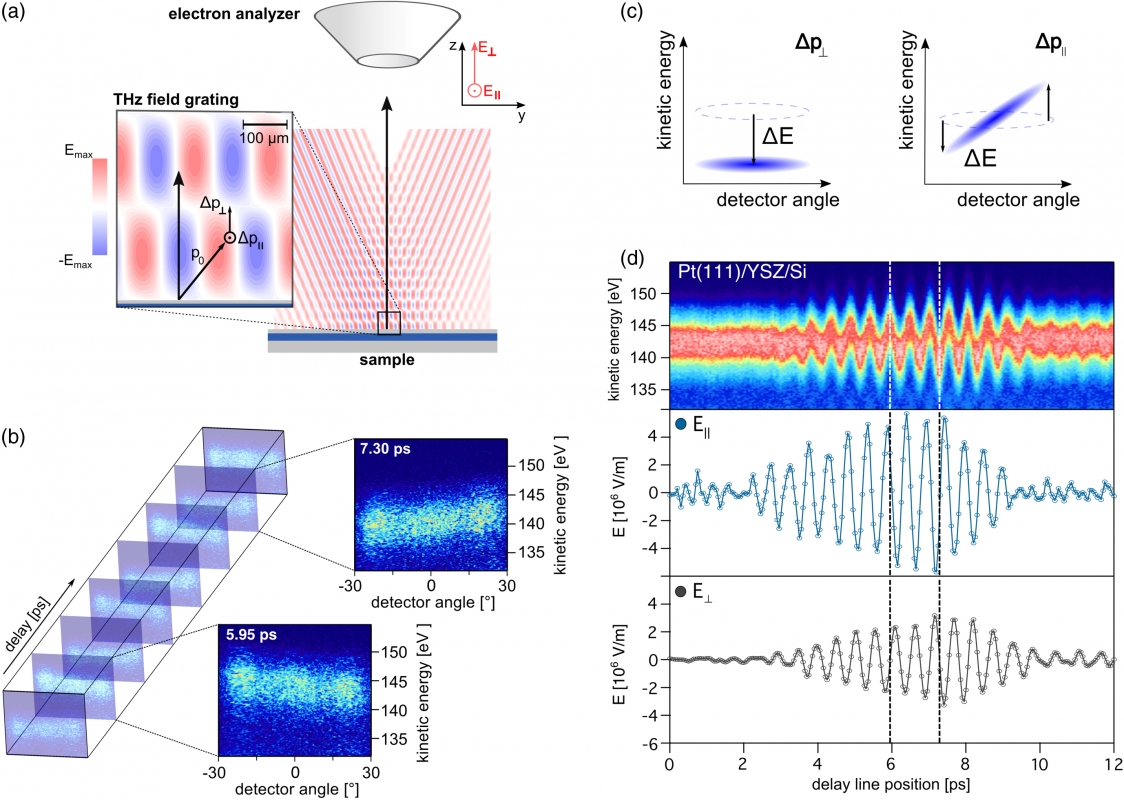Effective THz fields on nano-structured surfaces
November 13, 2019Polarization-sensitive field reconstruction in a THz/XUV pump-probe experiment at FLASH
Intense THz fields can be used to excite specific low-frequency modes in condensed matter or drive confined currents in nano-structured arrays, paving the way for a new class of optoelectronic devices. The long wavelength enables spatially confined field enhancement due to interaction with metallic structures and interference effects at dielectric interfaces. We use THz photoelectron streaking for the polarization-sensitive reconstruction of all electric field components at dielectric and metallic interfaces. This is realized in a THz/x-ray pump–probe experiment where x-ray emitted photoelectrons probe the effective THz field in close surface proximity. We observe distinct differences in the THz response of a nano-structured Pt thin film and a Pt(111) bulk crystal, in particular for the parallel field component. Simulations of the nanoscale spatial field modulation at metallic islands on the thin film provide design parameters for different sensitivity regimes with respect to local fields.

Fig. 1. Terahertz streaking scheme and polarization-sensitive pulse reconstruction. (a) Superposition of incoming and reflected parts of the THz pulse generate a complex field grating above the sample surface. The magnified inset shows possible momentum modifications of emitted electrons due to interaction with the E-field. (b) Stack of raw detector data of the Pt valence level at different THz/x-ray delays, showing the effect of tilting and shifting of the electron momentum distribution. (c) Schematics of the individual effects of the perpendicular (left) and parallel (right) field components on the momentum distribution. (d) Angle-integrated delay trace of the thin-film sample (top) and reconstructed field components parallel (center) and perpendicular (bottom) to the sample surface. Dashed lines indicate the delays of the detector images in (b).

Fig. 1. Terahertz streaking scheme and polarization-sensitive pulse reconstruction. (a) Superposition of incoming and reflected parts of the THz pulse generate a complex field grating above the sample surface. The magnified inset shows possible momentum modifications of emitted electrons due to interaction with the E-field. (b) Stack of raw detector data of the Pt valence level at different THz/x-ray delays, showing the effect of tilting and shifting of the electron momentum distribution. (c) Schematics of the individual effects of the perpendicular (left) and parallel (right) field components on the momentum distribution. (d) Angle-integrated delay trace of the thin-film sample (top) and reconstructed field components parallel (center) and perpendicular (bottom) to the sample surface. Dashed lines indicate the delays of the detector images in (b).
<<

 Ursula Keller wins “Swiss Nobel” Marcel Benoist Prize
Ursula Keller wins “Swiss Nobel” Marcel Benoist Prize Farewell: the NCCR MUST ended
Farewell: the NCCR MUST ended  MUST2022 Conference
MUST2022 Conference New scientific highlights
New scientific highlights FELs of Europe prize for Jeremy Rouxel
FELs of Europe prize for Jeremy Rouxel Ruth Signorell wins Doron prize
Ruth Signorell wins Doron prize New FAST-Fellow Uwe Thumm at ETH
New FAST-Fellow Uwe Thumm at ETH International Day of Women and Girls in Science
International Day of Women and Girls in Science New scientific highlight
New scientific highlight EU XFEL Young Scientist Award for Camila Bacellar,
EU XFEL Young Scientist Award for Camila Bacellar, Prizes for Giulia Mancini and Rebeca Gomez Castillo
Prizes for Giulia Mancini and Rebeca Gomez Castillo Nobel Prize in Chemistry awarded to RESOLV Member Benjamin List
Nobel Prize in Chemistry awarded to RESOLV Member Benjamin List Hans Jakob Wörner invited to give the „New Horizons Solvay Lectures”
Hans Jakob Wörner invited to give the „New Horizons Solvay Lectures”  Unusual keynote talk at an international scientific conference
Unusual keynote talk at an international scientific conference NCCR MUST at Scientifica 2021
NCCR MUST at Scientifica 2021